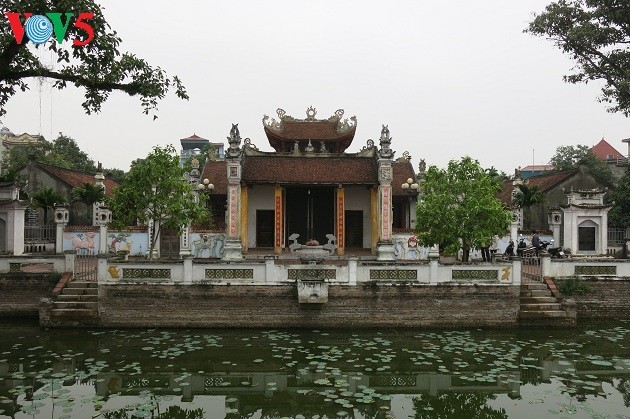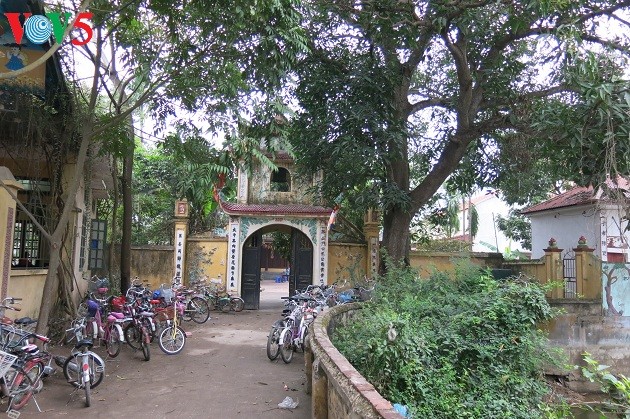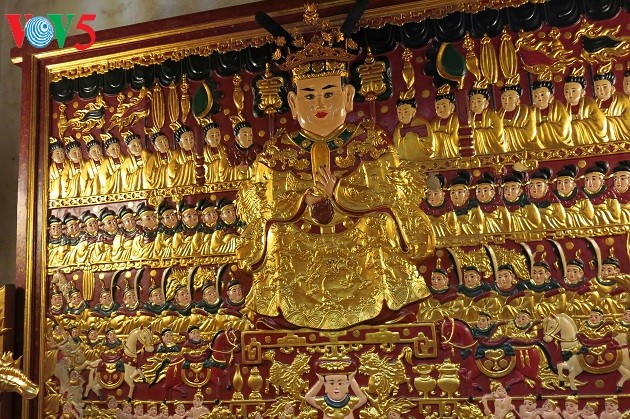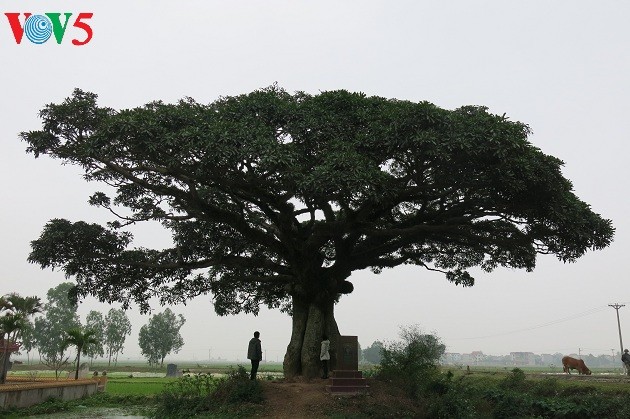(VOVWORLD) - Binh Da is an ancient village in Thanh Oai suburban district 20 km from Hanoi’s center. Also known as Bui Village, Binh Da was established under King Minh Menh of the Nguyen dynasty in 1820. Binh Da is famous for historical relics.

Noi Temple worshiping Lac Long Quan has kept traces from the Ly Dynasty to Le Trung Hung Dynasty. (Photo: Lan Anh/VOV5)
|
Binh Da village has 13 official historical relics and many other very old temples, pagodas, and shrines. It has been called the "holy land" because it is home to three religions of Vietnam – Buddhism, Taoism, and Confucianism.
Some of its rare and valuable relics date back more than 1,000 years. Items used in the village festival are still retained including incense tablets, a pair of parallel sentences created in 1919 in the reign of King Khai Dinh, and an old bronze bell cast in the year 1007.
Other works include ancient stone steles, a lotus pond, a jade well, and such treasures as some drums of the Dong Son culture and decorative bricks used to build the graves of the nation’s founders.
Binh Da village worships two tutelary gods: legendary founder of the nation Lac Long Quan at Noi Temple and Linh Lang Dai Vuong at Ngoại Temple.
 Quan Am Pagoda is one of 5 pagodas of Binh Da village. Quan Am Pagoda is one of 5 pagodas of Binh Da village. |
Bui Dang Thinh, Head of Binh Da village temple, recalls: "Legend has it that after bidding farewell to his wife Au Co, Lac Long Quan led 50 of his 100 children to the sea. He stopped in Binh Da village, Binh Minh commune, which long ago was called Bao Da Bao Cuu village. At the end of his life, he incarnated in Binh Da village. The locals buried him at Tam Thai Mountain, also known as Ba go, about 500m southwest of the temple. In the spring in 1077, Prince Linh Lang, son of King Ly Thai Tong, was stationed in the village and recruited troops there. He died when fought against China’s Song troops, and was posthumously honored by the Ly Dynasty as the Royal Highest Linh Lang. We still worship him as a village tutelary god.”
The Noi Temple holds many antiques including annals, inscriptions, a bronze bell, lacquered boards, parallel sentences, and tools used in sacrifice rituals from the Ly Dynasty to the Le Trung Hung Dynasty.

The relief hang in the sacred chamber is the most valuable heritage of Binh Da village.
|
A canary-wood relief of Lac Long Quan and all his civilian and military mandarins watching a boat race is the most valuable. In 2015, the relief was officially recognized as a National Treasure.
Thinh told us: "The relief is a sacred item dating back to the Dinh Dynasty, more than 1,000 years ago. The relief has 5 rows. On the top row are 18 maidens presenting petitions; the second row includes 20 civilian mandarins standing and awaiting questioning, and the third row has 16 military mandarins. In the middle is the founding father Lac Long Quan who is watching a boat race. Against the scenery of the river, rows of boats are ready for the race, below are teams of body guards, including elephants, horses, and a pair of white tigers, to protect Lac Long Quan. Apparently, in ancient times our ancestors could tame wild animals to protect humans.”
The Binh Da Festival is held from the 24th day of the second lunar month to the 6th day of the third lunar month each year. The 26th day of the second lunar month is observed as the death anniversary of tutelary god Linh Lang Dai Vuong and the 6th day of the third lunar month, of founding father Lac Long Quan. In 2014, the festival was recognized as a national intangible cultural heritage.
Pham Dinh Phung, head of Binh Minh commune’s People’s Committee, said: "On the fifth night a sacrifice ritual is held in the sacred chamber of the temple. The next morning a procession carries 50 holy cakes and casts them into the jade well, representing the 50 children who followed Lac Long Quan to the sea. Since ancient times, the Nguyen Van clan has been responsible for making the holy cakes. On the evening of the fifth day, all necessary tools and materials for making the holy cakes are brought to the sacred chamber. Nobody except members of the Nguyen Van clan are allowed in. The head of the family clan hands down the secret recipe from generation to generation."
 An ancient tree is said to closely link to Dinh Bo Linh who quelled revolts of 12 war-lords (944-968). An ancient tree is said to closely link to Dinh Bo Linh who quelled revolts of 12 war-lords (944-968). |
The descendants of the village’s Pham Dinh, Nguyen Van, Nguyen Doan, Bui Dang, and Bui Quang clans collaborate to maintain and protect the village’s historic relics.
Mr. Phung told us: "Most clans in the village have built their own worshiping temples and set up funds to encourage their descendants to study well. The children compete for awards every year. We also have funds to help those in need and promote economic development. Every year on the tenth day of the first lunar month, Binh Da people, wherever they are, return home to visit the local elders and attend the village festival.”